I admit it, I’m a bullet nerd. I’ve always been fascinated by ballistics, and particularly terminal ballistics. I enjoy learning about how bullets do their work, and studying the minutiae of expansion, penetration, retained weight, permanent and temporary cavities, testing protocols, and all the numerical measures of bullet performance.
Some of you are probably bullet nerds too. If we were sitting together around a campfire, we’d probably keep each other entertained into the wee hours with animated discussions about sectional densities, stories of hunting bullets that brought down game, or the best carry loads for our gats.
That’s all good fun, and sometimes it can even be useful (for more than starting bar fights). Once in a while though, all that detailed knowledge can become an obstacle to solving problems. We bullet nerds sometimes have a tendency to lose the forest through the trees.
Death Rays,stopping power, and Other Lies
Consider the case of a budding RevolverGuy who contacted me recently, seeking a recommendation for a defensive load.
Our RevolverGuy was relatively new to shooting and had been shooting a steady diet of mildly-loaded, standard pressure, .38 Special ammunition in a Ruger LCR with Magnum chambers. Before finding us, our RevolverGuy had sought advice from local experts, and the bullet nerds in the community insisted that 125 grain, .357 Magnum loads were the way to go. All their graphs, charts, tables, and slide rules told them that the .357 Magnum was the King of “stopping power,” so why would anybody choose something less?
Our shooter reached out to us here at RevolverGuy, after discovering the blog, and asked what we thought of that advice. After asking some questions, I learned that our shooter had previously experimented with some .38 Special +P, 125 grain loads and things didn’t go so well. Our shooter’s formerly tight, well-centered groups turned into shotgun patterns with a bunch of low, 6 O’Clock hits that betrayed some recoil anticipation. The shooter admitted to being uncomfortable with the recoil, and had left the majority of the box of +Ps unfired. In police work, that’s called a clue.
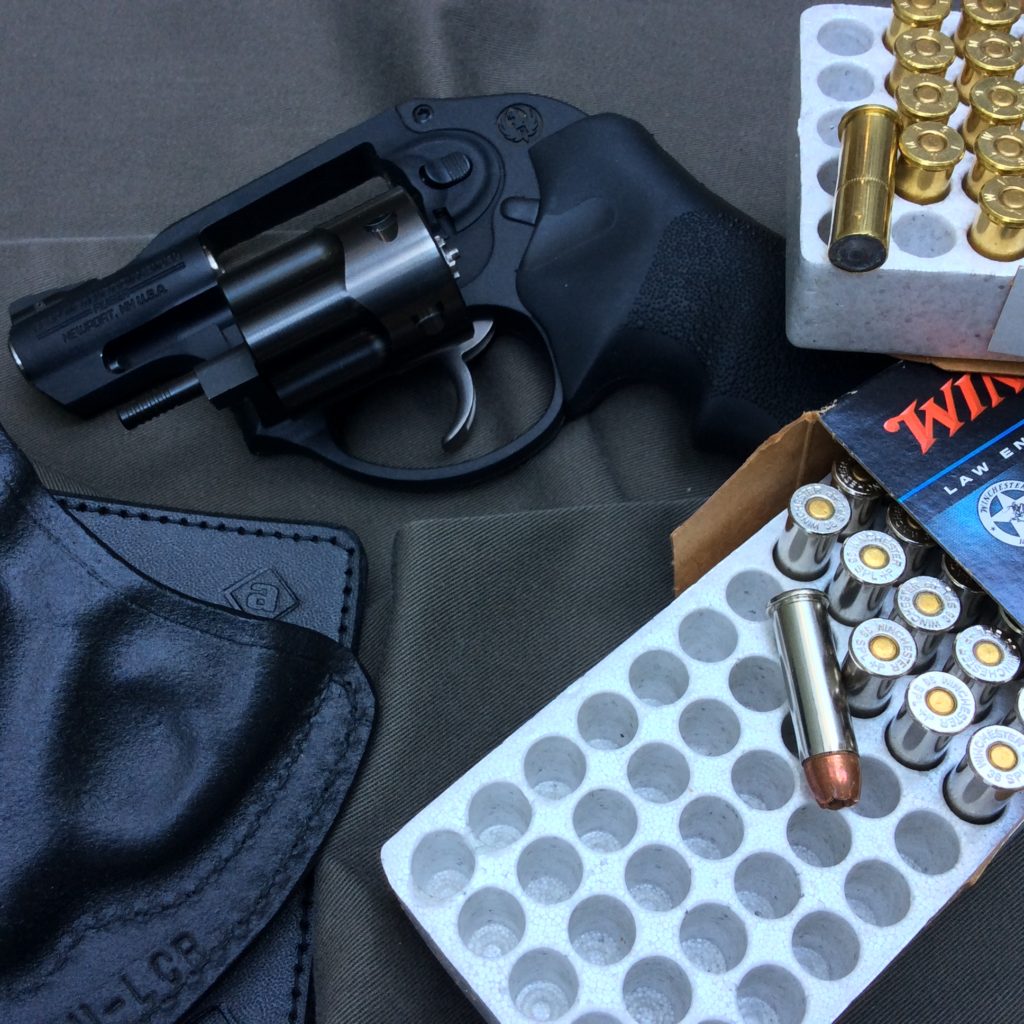
After the experience with the .38 +P loads, the thought of shooting .357 Magnum had our shooter concerned. I could almost hear the sigh of relief through the wires when I told our friend that it wasn’t necessary to carry Magnum ammo in a Magnum revolver, and that I wouldn’t do it myself in the Ruger LCR. Instead, I’d look for a .38 Special load that I could control well enough to guarantee accuracy and fast follow-ups. No Magnums for me in a lightweight snub, thank you very much.
Reality Check
The bullet nerds were trying to be helpful, but they didn’t do a very good job of reading the situation and tailoring their advice for our friend. Sure, some .357 Magnum loads have developed a pretty fierce reputation as manstoppers over the years, but in the quest to choose the best numbers from a table or spreadsheet, the view of the big picture was lost.
Our RevolverGuy didn’t need the biggest and the baddest bullet on the block. The .357 Magnum earned its laurels when fired out of heavy, steel frame revolvers with 4 and 6 inch barrels, but when you put that much horsepower into a flyweight snub, it takes a very accomplished shooter to hang onto the reins and control it. Our friend isn’t there yet, and if we had stuffed the chambers of that LCR full of Magnum ammo, I can guarantee it wouldn’t have been pretty or effective. The most powerful and capable bullet does you no good if you can’t connect with it, eh?
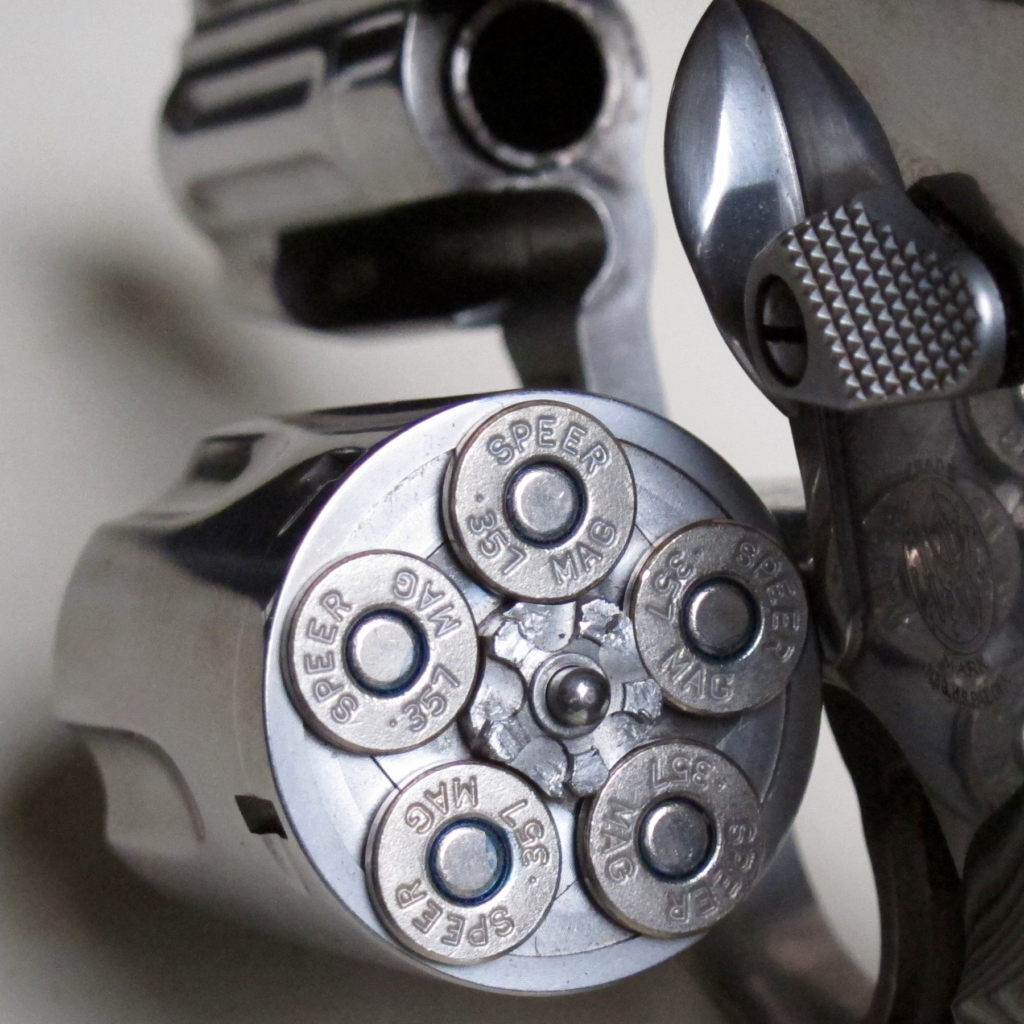
Right. So, after some discussions and some testing, we found a better solution for our friend, and that solution was about as far from the fire-breathing Magnum as you could get. In fact, it was the polar opposite. The solution was the .38 Special, 148 grain wadcutter.
Priorities
Some of my fellow bullet nerds are thinking that I lost my marbles right about now. In an era of hi-tech hollowpoints, why in the world would I recommend a low speed, solid lead, soup can of a target round for defense?
To explain, we start with establishing some priorities for choosing defensive ammunition:
1. Reliability. The first priority of defensive ammunition is reliability. It must absolutely go “BANG” when we want it to, and it must not interfere with the proper function and operation of the gun;
2. Accuracy. Here, we take a broader look than just precision. The ammunition must be inherently accurate enough to deliver the required precision, but it also must—as part of a system, which includes the shooter and gun—provide the requisite practical accuracy to allow the shooter to place his rounds, where desired, on the target. This is not just a measure of raw precision, but of control. A hyper-accurate load with vicious recoil that is too stout to manage will not allow the required practical accuracy that we need;
3. Terminal Effectiveness. The ammunition’s ability to damage the target should be maximized to ensure the greatest terminal effect, given the bullet’s available energy, after penetrating through reasonably anticipated barriers;
4. Logistics. The ammunition must be sufficiently affordable and available to merit consideration;
5. Other Considerations. Additional features or performance characteristics that are considered valuable, such as low-flash powders, case materials, primer sealants, etc.
Evaluating the field
When we looked at the most likely jacketed hollowpoint options in .38 Special and .357 Magnum, none of them fared well when we measured them against these priorities for our friend. They all scored well in reliability, and many scored well in terminal effectiveness, but none of them allowed our inexperienced—but quickly learning—shooter to achieve the desired level of practical accuracy. Our shooter’s level of strength, skill and experience didn’t currently allow them to control these powerful loads sufficiently enough to rely on them for defensive duty (including the .38+Ps). Since even the most sophisticated hollowpoint can’t do anything for you unless you can put it in the right place, we had to look for another option.
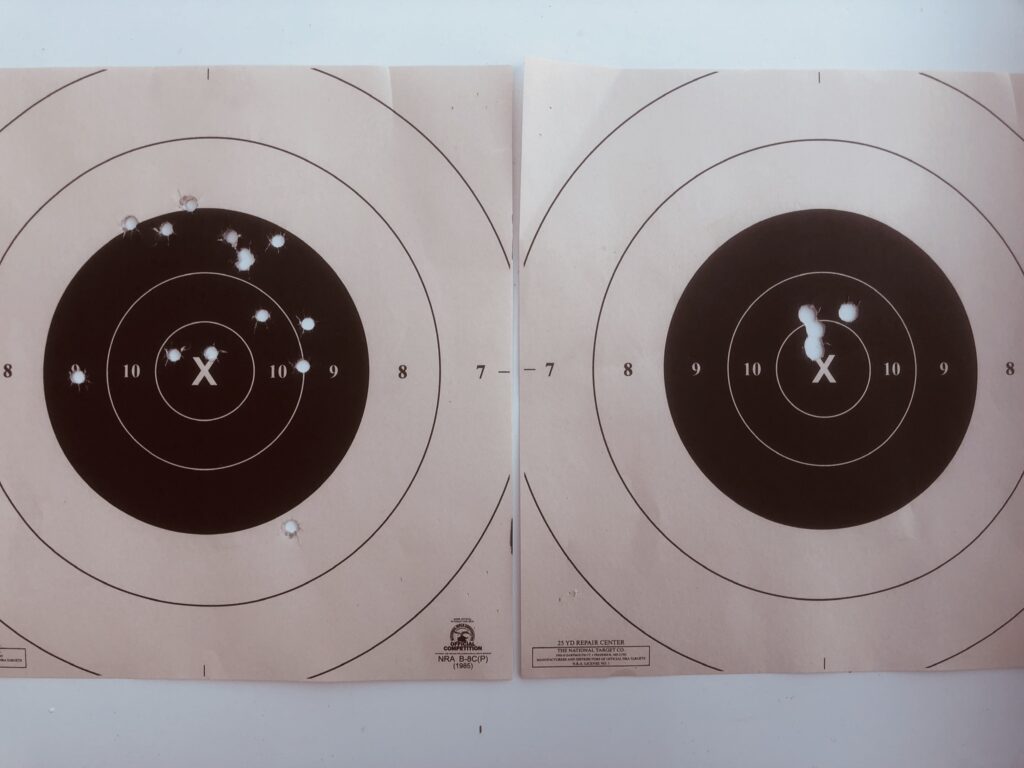
Some of the “low recoil” hollowpoints that are commonly touted as solutions for recoil-sensitive shooters were considered, but found to be lacking. In some cases, the “low recoil” label seemed to be more marketing hype than reality, and in others, the terminal effectiveness of the round was compromised by the changes that were made to enhance control.
The wadcutter alternative
In contrast, the lowly wadcutter was a much better fit for our shooter, when we evaluated it with the priorities in mind.
Factory wadcutters offer reliable ignition and operation in a revolver. In fact, the abbreviated power of a 148 grain wadcutter might conceivably offer a greater level of mechanical reliability than a high-pressure round that abuses the gun with greater force (causing problems like timing issues or endshake) and increases the risk of primer flow, bullet pull, internal lock engagement, or sticky extraction.
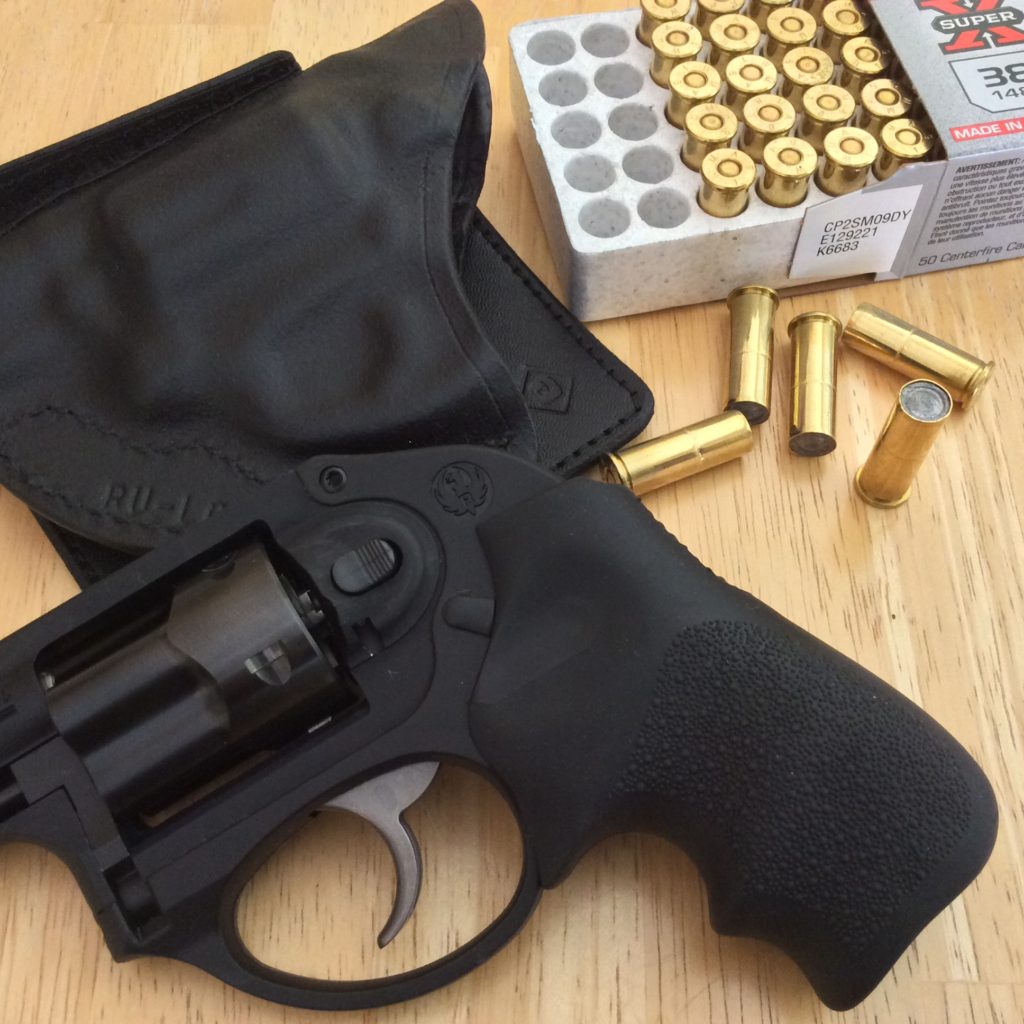
The .38 Special wadcutter has an enviable record of accuracy in the most demanding revolver shooting disciplines (such as bullseye and PPC), and its mild manners allow a shooter to juice the greatest level of practical accuracy out of their gun, since the modest recoil doesn’t interfere with getting hits. Furthermore, the .38 Special, 148 grain wadcutter frequently shoots to point of aim on fixed sight guns, which eliminates the need for manual corrections by the shooter, and enhances the likelihood of precision under stress.
But what about terminal effectiveness? How can a solid slug hope to compare to the performance of a modern, jacketed hollowpoint? Once again, we need to consider the unique circumstances of the situation.
The special nature of the .38 snub
Like the .380 ACP cartridge, the .38 Special doesn’t have a lot of surplus energy to work with, and it can be highly sensitive to the velocity losses sustained in short barrels like that of the Ruger LCR (1.87”).
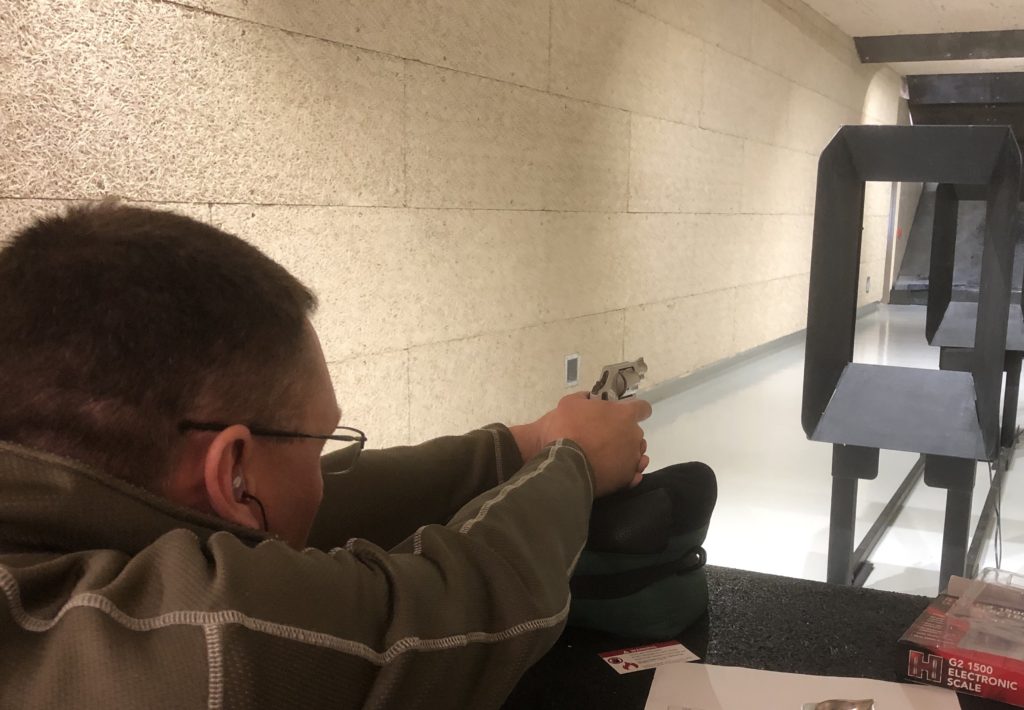
When you go from a 4” barrel to a 2” barrel, it’s not uncommon to lose around 100 feet per second (fps) in many .38 Special loads. Normally, a loss of this magnitude wouldn’t be all that critical for a handgun round, but in the case of the .38 Special fired from a 2” revolver, that loss can move the bullet out of its “performance envelope” and rob the bullet of the minimum energy needed to perform as its designed. A round that expands well when it’s fired in a longer barrel may fail to expand much at all when fired through the shorter tube of a snubby, because the bullet strikes with insufficient energy to open up the hollowpoint.
You can increase the pressure of the round (SAAMI +P, or non-SAAMI +P+), to drive the same slug at a greater velocity and promote expansion, but this comes with an attendant increase in recoil energy, and makes the ammunition harder to control—particularly for a recoil-shy shooter.
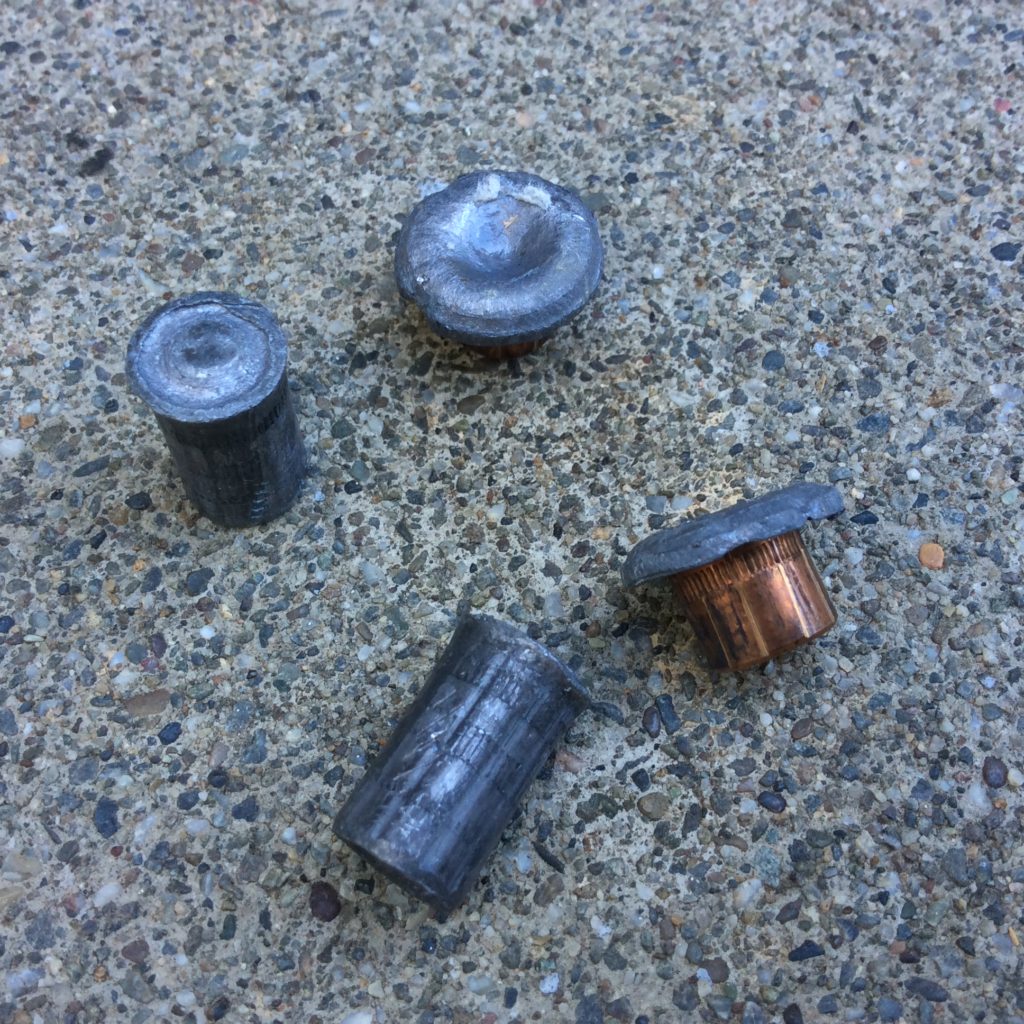
To solve this dilemma and keep recoil at a reasonable level, some designs use a lighter and faster projectile to promote expansion, or use some clever engineering (most often, with a light-for-caliber bullet) to get the bullet to open up out of a short barrel.
Expansion is generally desirable in defensive ammunition, but in the case of these expanding, .38 Special loads, it may also lead to shallow penetration. Most .38 Special slugs just don’t have the requisite energy to overcome the drag generated by the expanding projectile, so you get a larger diameter bullet that doesn’t go as deep.
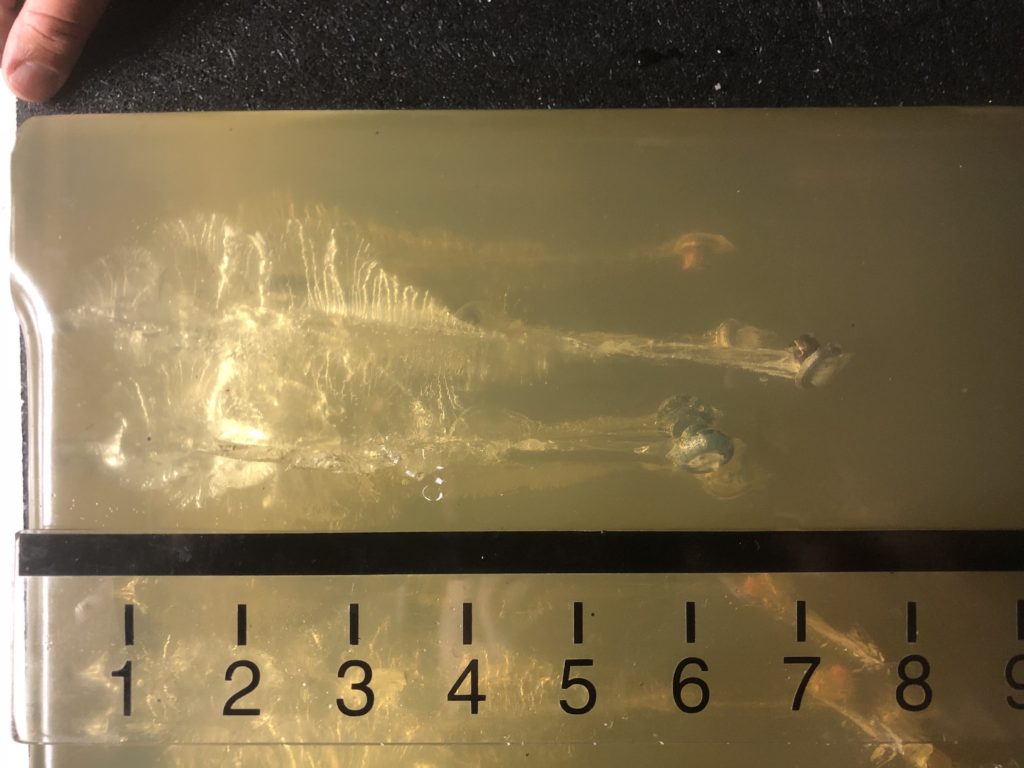
There’s no free lunch in ballistics–especially in .38 Special snubby ballistics. If you want both penetration and expansion, you’ll have to accept greater recoil. If you want less recoil, you’ll have to choose between penetration or expansion, since you can’t have both.
What the wadcutter’s shape can do
The 148 grain wadcutter is as soft-shooting as it gets in .38 Special. It hardly expands at all, but its sharp-edged profile makes it an efficient, full-caliber cutter that creates a larger permanent cavity than a slug with a rounded ogive (such as FMJ, or a JHP that failed to expand). The pointy, rounded bullet will slip through tissue and leave a wound track that’s smaller in diameter than the bullet itself, because the tissue will temporarily stretch to allow the passage of the bullet, then recover. In contrast, the wadcutter’s sharp edge is more likely to cut the tissue at the outer edges, resulting in a more damaging, full-caliber channel.
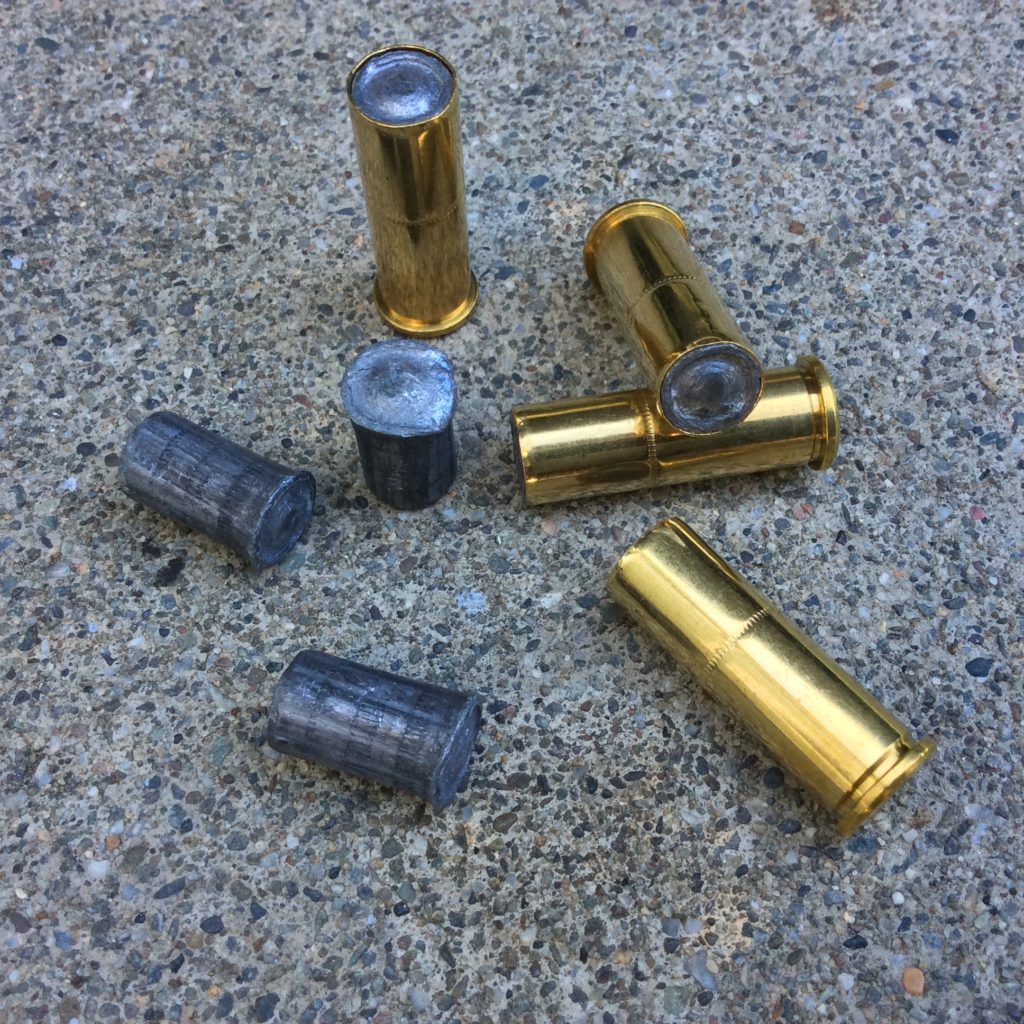
The sharp corner of the slug also allows the bullet to “get a bite” and “dig in” when it hits a rounded or angled surface (like a skull, or other bone), instead of glancing off harmlessly, like a bullet with a rounded profile might. In fact, veteran police gunfighter Jim Cirillo incorporated this feature into a bullet of his own design, after seeing how the square corner could grab hold and allow the bullet to do some work.
It’s interesting to note that when American police were carrying lots of .38 Special revolvers loaded with solid projectiles, there was a belief in some circles that the square-shouldered wadcutters and (to a lesser extent) semi-wadcutters did a better job than round nose lead bullets. The flat meplat and square shoulders of the wadcutters were thought to deliver greater shock and create more trauma than the rounded profile bullets with their pointy noses.
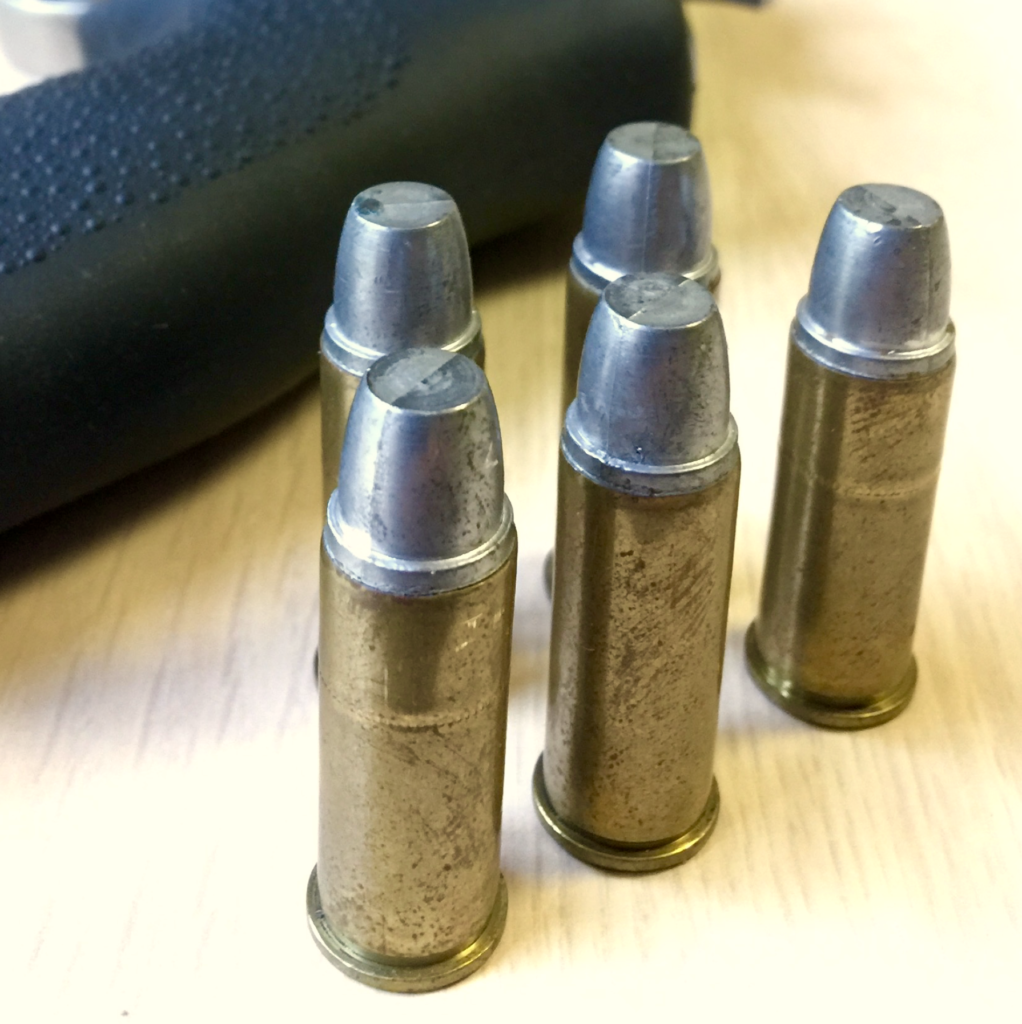
Anecdotal evidence and testimony indicates that the police officers in New York City who were issued semi-wadcutters generally had a more favorable impression of their ammo performance than the officers in Los Angeles who were issued round nose lead bullets. In fact, several credible sources have told me that the really “switched on” officers in many Southern California agencies would load their duty guns with 148 grain wadcutters in lieu of the issued, 158 grain round nose lead, because they were more effective at stopping bad guys. If questioned about the non-regulation ammunition, they simply planned to claim the wadcutters were left in the guns accidentally, after training. The risk of being punished for a policy violation paled in comparison to the perceived advantage of having more effective ammunition in the gun for duty.(1)
Jello Junkies and penetration
In the wake of the horrific 1986 Miami Firefight—in which two FBI agents were killed, three were grievously wounded, and another two were injured—the Bureau conducted a series of Ballistic Workshops to enhance our understanding of terminal ballistics and develop improved standards for duty ammunition.
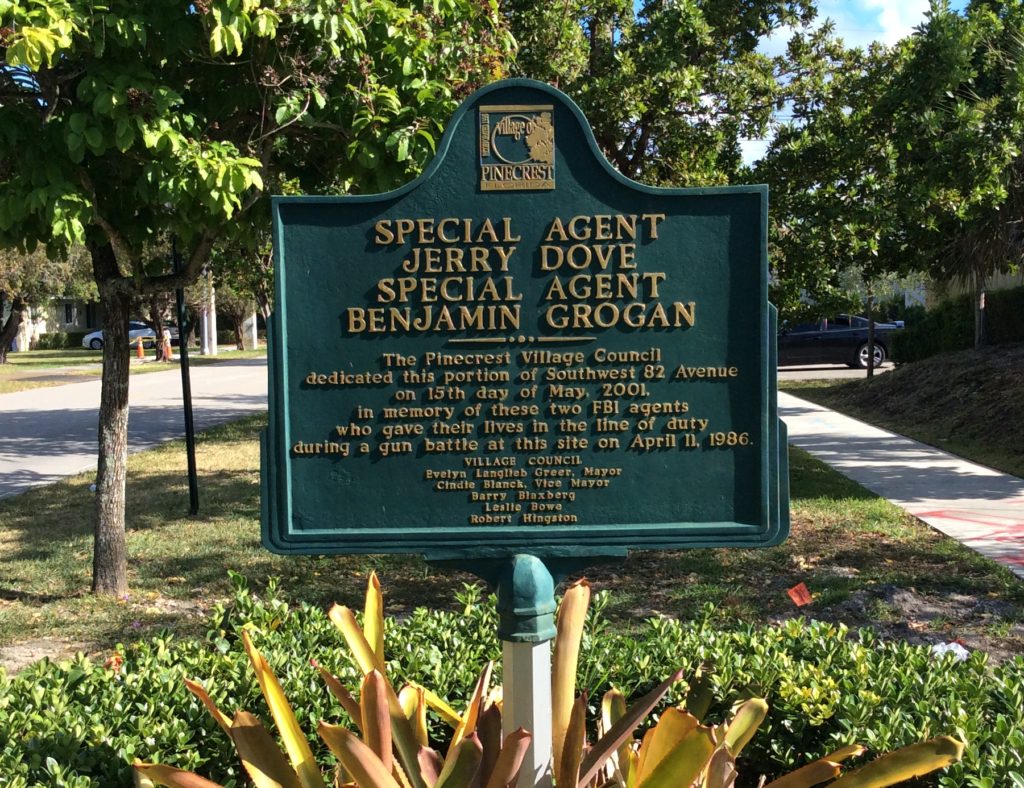
One notable result of this work was the development of a new ammunition testing protocol, which used 10% calibrated ordnance gelatin as a tissue simulant. In the new FBI test protocol, a handgun bullet was evaluated for its ability to penetrate, expand, and retain weight after being fired through a series of intermediate barriers into calibrated gelatin.
The protocol revolutionized the way that manufacturers designed and tested their ammunition, and gave the industry a common standard for the very first time. While the protocol isn’t perfect, it’s still the best measuring tool available, and has served well as the industry’s standard for decades.
With respect to penetration, FBI standards penalize a bullet that is unable to consistently penetrate a minimum of 12 inches in the calibrated gelatin (including after barrier penetration). In the FBI’s estimation, a bullet that penetrates less than 12 inches of calibrated gelatin risks being unable to reach the vitals, and is unfit as a police duty round.(2)
By this measure, many .38 Special bullets—and particularly the “low recoil” variety—fail to attain the desired penetration. They struggle to reach a depth of 10 inches in bare gelatin, particularly if any bullet expansion occurs, because they lack the energy to overcome the drag created by the expanding projectile.
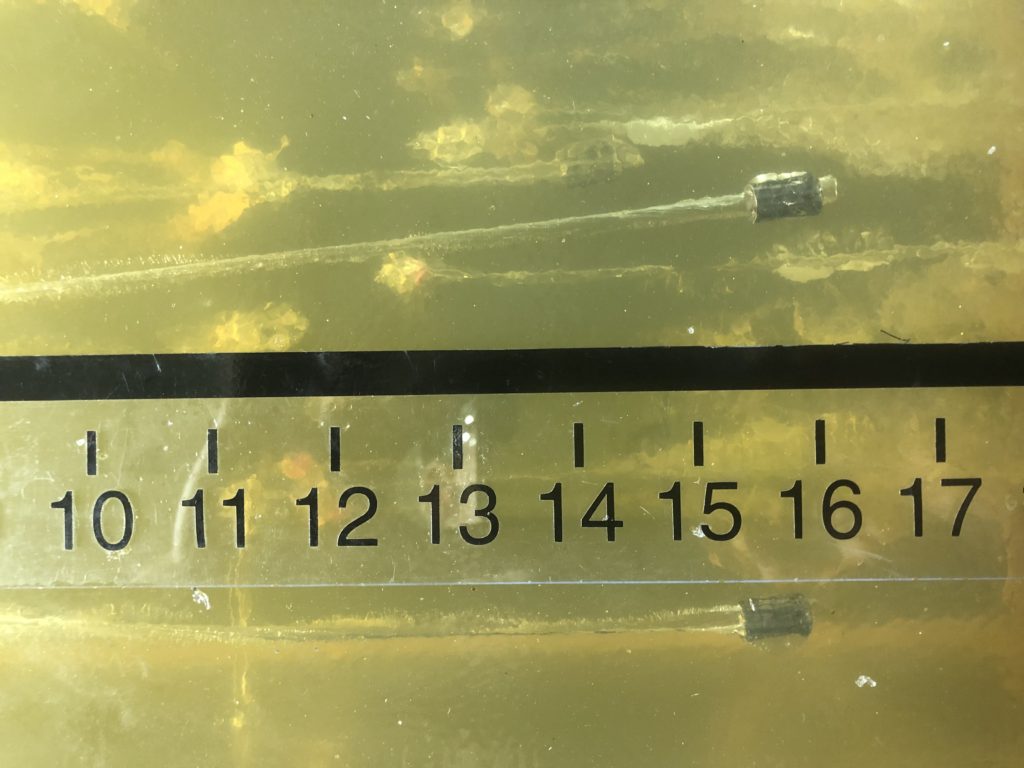
In contrast, the wadcutter easily goes deep enough to pass muster. It can reach the desired 12 inches of penetration in bare gelatin without difficulty, even when fired from a snubby. It won’t expand much at all, but it also won’t run out of steam prematurely.
The FBI protocol also penalizes a bullet that penetrates too deeply. Bullets that penetrate more than 18 inches in calibrated gelatin are deemed undesirable, since they’re considered inefficient and may overpenetrate the target, endangering an innocent.
The lowly, 148 grain wadcutter fares well against this standard, too. The typical, low power, soft lead, target load does around 600-700 fps out of a snubby revolver, and penetrates around 16 inches in bare, calibrated gelatin.(3) Some varieties of wadcutters are loaded hotter than others, and some wadcutters are cast from a harder material, which may cause penetration beyond 18 inches in calibrated gelatin, but this may not be an actual problem in the real world. While 10% calibrated ordnance gelatin is a reasonable tissue simulant, it’s not perfect–bullets often act much differently in bodies than they do in gelatin. A bullet that looks like an “overpenetrator” in gelatin might turn out to be just fine in the real world, where it has to defeat a non-homogenous, clothed target.
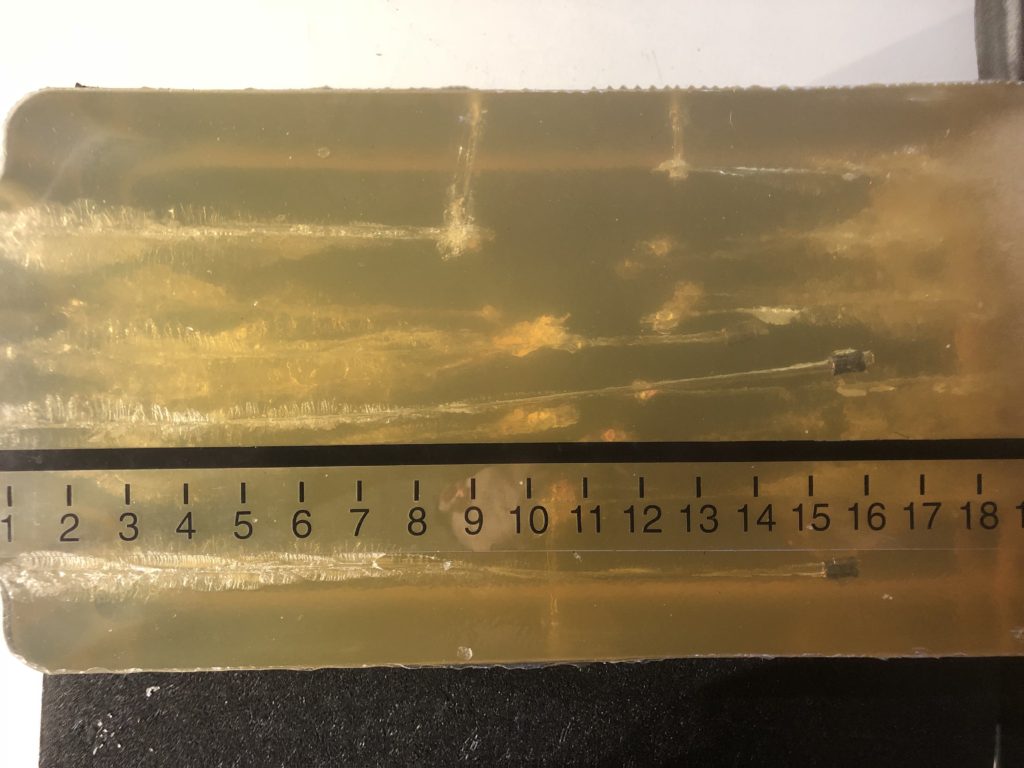
A medium-sized, Southern California police agency’s experience is instructive, here. This agency issues 1911-pattern pistols to its officers, and for many years their issued round was 230 grain FMJ, or “hardball.” The “Jello Junkies” would have you believe that hardball is a reckless choice for a duty round, because of its propensity to penetrate deeply in calibrated gelatin, but this agency’s actual experience in the street was quite different. In actual shootings, the agency found that the bullet usually stayed within the target. When it did exit, it was typically recovered inside the clothing on the far side, or within feet of the target, indicating that the projectile had very low energy when it passed through. The laboratory tests indicate that hardball should have poked through like an ice pick, but the reality on the street was quite different.
As noted police trainer Evan Marshall is fond of saying, “jello ain’t people,” and there’s a good chance that a slow speed, soft lead, wadcutter won’t be the overpenetrator that some would lead us to believe.
a tradeoff
One inescapable fact about the wadcutter is that its profile makes it more difficult to load into the chambers of a revolver. The longer, pointed shape of the typical hollowpoint bullet helps to guide the cartridge into the chamber, but the squared-off shape of the wadcutter is more likely to hangup on the edges of the chamber and give you fits.
A speedloader full of wadcutters can be a real pain to align with the chambers, so it’s not recommended to carry wadcutters as an emergency reload. Load your gun’s cylinder with wadcutters for carry, but choose a load with a more friendly ogive for your speedloader or ammunition strip.
Since reloads are a statistical rarity in armed citizen confrontations, this limitation might not be as significant as it first appears, but it’s still an important consideration when choosing wadcutters for defense.
Bottom Line
So, am I saying that target grade wadcutters are always the best choice in defensive ammunition for .38 Special revolvers?
Absolutely not. We know there are more sophisticated bullets and loads out there which can squeeze every last bit of performance out of the .38 Special, particularly out of service-size guns. These loads will generally expand more, and deliver more energy to the target, even after going through heavy clothing. The wadcutter can’t achieve what they do, with its solid construction and low velocity.
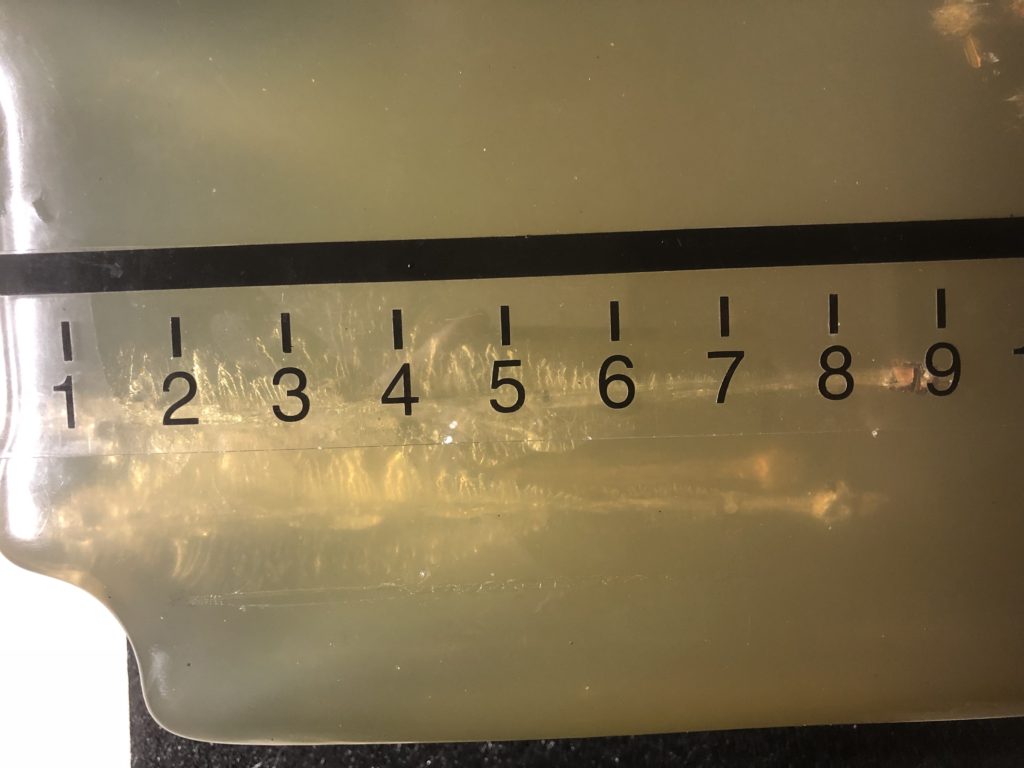
However, the wadcutter can also do things that they can’t. The wadcutter can be fired in flyweight, alloy/polymer guns without causing you pain and physical damage, and can also be safely fired in guns that are not rated for +P pressures (like many older Smith & Wesson and Colt revolver models). It can also be easily managed by someone who lacks the strength, technique, physical health, or experience to manage a harder kicking cartridge, and provide them a reasonable defensive alternative. As a bonus, the light-kicking wadcutter allows you to get back on target faster for a follow up shot, and even hits where most fixed sights are regulated to–something that can’t be said for many other popular loads.
The wadcutter isn’t just a defensive load for neophytes. There’s some pretty serious professionals out there who rely on it in their own guns, mostly because it has little recoil and they’re not convinced that the terminal ballistics are significantly handicapped.(4) The wadcutter allows them to shoot fast and straight with their snub revolvers, and since bullet placement is the most important element of terminal ballistics, that’s not an advantage to be overlooked.
The wadcutter may not be the “ultimate manstopper” of gun magazine cover lore, but for some shooters, it hits the sweet spot between penetration, power, accuracy and speed. The bullet nerds may not like it much, but it will do the job if you can do your part.So, don’t be too quick to dismiss the .38 wadcutter as a defensive round. It might be just the ticket, depending on your needs.
Be safe out there!
Support Us on Patreon!
First of all, a huge THANK YOU to our Patrons. If you’re not a patron, please consider supporting us – we can’t do this work, at this level, without your continued support.

Notes
1. We hasten to note this was a different era, and policy violations of this type were handled much differently than they would be today—this is not a recommended practice for today’s officers, who serve in a much different legal environment. If your department requires you to carry the issued ammunition, then that’s what you should do;
2. I’ll note that while the FBI’s 12″ minimum has become the de facto industry standard, there are still reasonable disagreements about it. Some loads (like Federal’s 9BPLE–a 115 grain, 9mm+P+ jacketed hollowpoint) regularly fail to meet the 12″ gelatin penetration standard, yet have excellent track records in actual police shootings. This has led some people to discount the 12″ standard as arbitrary. I won’t attempt to referee that discussion in these pages, but will simply note that the FBI feels 12 inches of penetration in 10% calibrated gelatin is an appropriate minimum for a law enforcement bullet, and the industry has responded with ammunition that meets the expectation. Armed citizens may come to different conclusions about the requirement to penetrate 12″ in gelatin (including after intermediate barriers), but the greater law enforcement community has accepted this standard for police duty ammunition, so that’s what the manufacturers are building;
3. In a test I conducted using bare, 10% calibrated gelatin (0.177 inch steel BB fired at 592 fps with penetration of 3.175″–the FBI Spec is 2.95″ – 3.74″ for a 0.177 inch steel BB fired at 590 +/- 15 fps), three 148 grain wadcutters were fired from a S&W 637 at a distance of 10 feet. The three projectiles penetrated 15.0, 16.0 and 16.5 inches with minimal expansion (.405″, .401″, and .386″, respectively), easily besting a host of 90, 110, 125 and 130 grain projectiles that were fired alongside it, which penetrated around 9 inches, on average;
4. Friend Mas Ayoob points to such notables as Duncan MacPherson, Dr. Gary Roberts, and Chuck Haggard as examples. You can also count Daryl Bolke in that group.

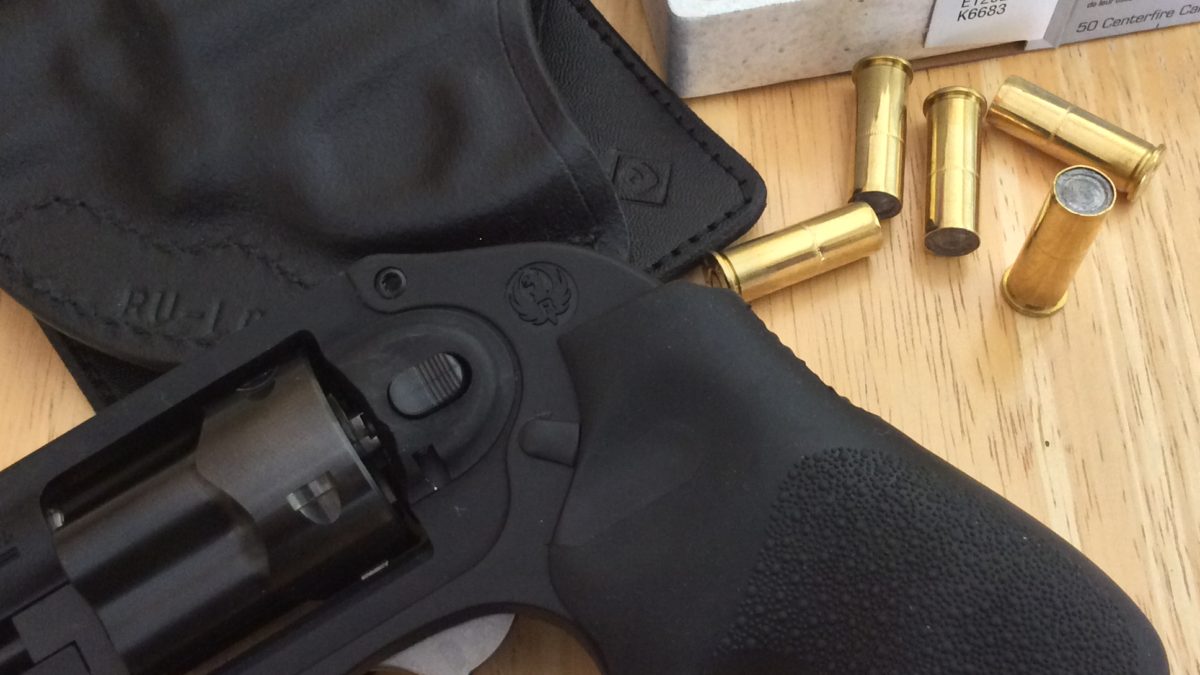

Bravo, Mike!
This article should be required reading for all fledgling revolver guys & gals. Lots of wisdom here for all who favor small revolvers; consider giving wadcutters a serious look. The fact that wadcutters are controllable in a 12-16 ounce revolver is huge. Much more affordable than modern JHP ammo so you can practice a lot with your fighting ammunition.
Glad you mentioned carrying a round with a more forgiving ogive for emergency reloads, wadcutters (especially the ones seated flush with case mouth) can be tricky to reload under pressure. Wadcutters will strike closer to point of aim than light turbo speed bullets until manufacturers give us front sight height options (Too much to hope that new .38 revolvers would ship with 2 front sights- a 100 gr. & a 135+ gr. easily changed ramp.) Good stuff here, Thank you!
Kevin, I hear you LOUD and CLEAR about those front sight heights! It wouldn’t take much to help us out! Glad you enjoyed the article.
Great contribution Mike! I wish I’d found this 3 years ago. How snappy is a Winchester 148gr full wadcutter at 700 fps out of a 13 ounce LCR? That’s about 166 ft. lbs. of muzzle energy. Is there a magic number to stay below? I’ve owned both a Ruger LCR and a Smith & Wesson ultralight in 38 special and was completely beaten down by my determination to only run + P ammo through them. I finally gave up because I couldn’t take the pain anymore. Then I tried to get the micro and small 380 autos to work for me but they are miserable pocket guns. Out of a reasonably sized pocket, I cannot get a good draw with either a Glock 42 or a Ruger LCP Max. First off, it’s really hard to get a good grip on the gun plus the back of the slide keeps snagging in my pocket. This really surprised me because my Smith & Wesson model 640 Pro never snags, and it’s actually physically a little bit larger than the Glock. It’s also VERY easy to get a good grip on the j frame in a panic situation with no concerns about the feeding failures that plague the small semi autos when I have less than an ideal grip. I feel like I have to do this dance around the tiny semi autos just to get them to run right. The safety issue is also a big deal for me. I always feel a little bit uneasy having a striker fired weapon in a pocket. With a J frame I can totally relax knowing I’m not going to shoot myself. I no longer care if a j frame only has five shots, at least I know those five shots are gonna work. Thank you Mike for bringing me back home to what’s really important.
Kindest regards,
Keith.
Hi Keith, I’m glad you found us and the article!
I’ve lost track of how many people I’ve seen go through the same cycle that you did. Many shooters in the younger generation simply enter the loop at the small autopistol stage, instead of struggling with the hot loads in snubs, first, but the problem remains the same—-while the small autos are convenient to carry, they are difficult to employ effectively, and suffer reliability issues.
I wrote about this in an article you may enjoy, while I was still writing at Police1: 15 Reasons to Consider a Snub
The 148 grain wadcutter shoots very soft and won’t be “snappy,” even in your flyweight LCR. It’s very comfortable to shoot, and I think you’ll really like it. If you haven’t seen it yet, I’d strongly encourage you to take a look at my writeup on the .38 LCR to see more discussion about felt recoil in that platform: The .38 Special Ruger LCR
Thanks for writing, and please check back in to let us know how those wadcutters treat you!
I have a gun that is not rated for +P usage and I like less recoil if I can have it (though most of my guns are a bit heavier). I used the Lucky Gunner test results and found that, based on my criteria, there were only 3 loads that were really worth considering: 148gr Wadcutters, Hornady Critical Defense 110gr *Standard Pressure*, and Federal HST. I chose to go with the Hornady load largely because I wanted the easier reloading and didn’t want to juggle two different loads. I am comfortable with the slight loss in penetration, but it is there.
That said, I absolutely do not fault anyone for choosing wadcutters. As you pointed out, they do pretty much everything you could want (except expand, or course) and they have the added benefit, at least in the Lucky Gunner test, of maintaining very consistent performance out of different barrel lengths if that is relevant for someone.
Greyson, I’m curious . . . how close does that 110 grain Hornady load hit to your sights?
It depends on the gun. In my 3″ SP101, it is only about an inch low at about 7 yards. That said, I do notice more difference in my LCRx, where it is about 2-2.5 inches low. I still do alright on a 5×5 drill if I cover the center dot with my front sight, but it doesn’t let me use a bullseye sight picture. Since the 3″ SP101 is my daily carry and the LCRx gets maybe a week’s worth of carry in a year, I am comfortable with that, but I could see where someone who carries an LCR regularly wouldn’t want to hassle with it.
An inch at 7 for the 3”, so what about at 25?
If you’re 2+ inches off at 7 with the 2” gun, I wonder what that would look like at 25, too.
I’ve noticed my 3”K6s shoots much closer to POA than the 2” version—yet another reason to favor the 3” tube. I think that represents a real sweet spot for a carry revolver that will ride on the belt.
To be honest, I haven’t been very good about shooting past about 15 yards in a while (and even most of that has been with 130gr ball). I should probably give 25 yards a try with the Hornady. At the very least, I really ought to know what it does at that range, and it might change my mind about carrying it outside of known environments.
The more I think about this subject, the more I am inclined to switch to wadcutters. Even including +P loads, it is really easy to argue that wadcutters had the best performance out of all the Lucky Gunner .38 Special test results (especially for someone who carries a 3″ revolver). Also, I recently watched the Paul Harrel video on why he doesn’t like “Hyper” (boutique and defense-specific) ammo. I think his idea of the “precious effect” has been very relevant for me. I don’t want to shoot too much of my precious, expensive defense ammo. Using wadcutters would make it a lot more economical to have my practice and carry loads be the exact same thing. That in turn would avoid issues of differing points of impact and the like. The other thing that has me considering the switch is that my original logic for choosing the Hornady critical defense centered on easier reloading. The problem with that logic is that I haven’t been carrying reloads very much. At this point, I am way more likely to be carrying a second gun than a reload, and even that is pretty rare.
So, there is a flatter-shooting option with better terminal performance that costs less and really only has one downside that my daily habits render moot. Why am I not carrying this wonder-round?
Haha! Sounds like I’ve created a monster! Tell ya what, Greyson. How about loading with wadcutters, and throwing a speed strip of the Hornady CD’s in your pocket? They won’t take up much room, and you’d have all the bases covered.
Mike, I do not trust my Taurus 85 stainless with too many +p loads, so I use that Hornady std. pressure in the gun, now relegated to fishing-vest carry.
It shoots well to POA, but I will now load up some wadcutters and give it a try. All my other guns are all steel and +p rated.
Thanks for a great article Mike! I also will point out that the only readily available SJHP load in .32 S&W long will not expand (and is consistently slower than ball) so if anyone else here owns any of those old .32s they are best carried with wadcutters. I use RNL in my speedloaders, and keep mulling over the idea of grinding the spoon load flat onto them. I’m just not sure that doing so makes any real difference, and of course, liability.
Riley, I’m not well versed on the .32 Longs. Are there any factory wadcutters for them? I only remember seeing RNL.
Fiochi and Federal both make them… Federal only come 20 to a box, IIRC
Thanks Riley! I just checked and the Federal site indicates the .32 Long WCs are “discontinued,” so I’m glad Fiocchi is still making them.
Dang!
A VERY appropriate writeup for a category of gun that is one of the more difficult to master – the snubbie.
I remember ages ago when Jim Cirillo was on the ‘stakeout squad’ that it seemed the wadcutters from his revolvers (yes, he carried at least two) always seemed to make it on the street and into his ‘targets’. His reply to I.A.D. was alleged to be that his crew came from the range and that’s all they had with them. As you pointed out, good luck getting away with that today.
Not long after the earth cooled, and my backup/off duty gun was a M36 Chief Special (that I still have), the department issued .357 Magnums, which did absolutely no good in Roscoe in the early 1970s. Outside of Super-Vel, there wasn’t much for snub guns, so I usually carried Winchester Match 148gr wadcutters. Winchester used soft swaged bullets and they clocked a bit faster than the Remington or Federal loads. They were so easy to shoot.
For anyone learning to shoot, and especially if you’re eyeing the carrying of a lightweight or snub .38 revolver, I would heartily recommend starting off with the light target wadcutter type loads. Reloading your own is a great way to learn about your ammo, and develop loads that work for your practice, and to find out what your upper level of recoil tolerance is. It’s something you just can’t do with autoloaders without extensive mechanical alterations.
It’s also good to keep in mind that over the last 110+ years, the .38 Special in the wadcutter and plain semi wadcutter configurations have more than likely planted more bad guys in the M.E.’s office than all the boutique loads that have come out in the last 40 years. It’ll do the job if you do yours.
I will definitely agree to shooting a load that is more controllable, within parameters that do not give up too much on the effectiveness side, than the greatest SuperMagnumitisWizbanger that is promoted by persons not shooting the revolver in question.
Along with this thought, I confess to shooting a WFN lead boolit loading of the 180gr variety in my revolvers, simply because it is VERY controllable in my revolvers for me, along with being more accurate than I am on occasion. Part of this confession is that I fall into the category of belief in heavy for caliber bullets (at moderate velocities) can be shot easier, more controlled, and deliver more energy in the target when needed, than a light bullet driven hard and fast….which results in more blast and recoil in the same revolver in my experience. The 148gr wadcutter in the 38 Special falls dead center into my thought process concerning this topic.
Good show with helping the shooter pick a load that works, NOT one that is simply the best from a gun magazine page advertisement.
It’s interesting to note that when Tim Sundles of Buffalo Bore designs his non-expanding ‘Dangerous Game’ heavy pistol bullets, the shape he chooses is a flat-nose with the widest-possible meplat— much like the wadcutter.
Thanks LB! Yes, that’s a good observation, indeed. Back before expanding hollowpoints were the norm for defensive handgun ammo, the bullets with wide, flat noses had the best reputations for hitting the hardest and delivering the most shock. Maybe it’s time for us to “rediscover” this?
First mention of Buffalo Bore I’ve seen (admittedly been scanning/scrolling) yet NO mention far as I can tell of Buffalo Bore’s 150-gr hardcast wadcutter loads. These are standard-velocity (850 fps) “low flash” snub loads.
Another great post, Mike!
Certainly there are many folks out there who are not ‘gun people’, but who feel the need to have a gun for self-protection. A .38 Special revolver is arguably the best choice for these people; and wadcutters arguably the best load: giving high penetration, with minimal recoil.
Outstanding! I use wadcutters as my first 5 in a Model 36. However, I use the Buffalo Bore 150 grain hard cast wadcutter rather than the 148 grain target loads.
As an aside, I have “Chicago Loads” in my speed loaders.
…Chicago Loads? Sounds intriguing…
The Chicago Load -a.k.a.+P 158 grain Lead Semi-Wad Cutter Hollow Points. In my Mode 36 I use either of the Remington, Winchester or Federal version I have on hand. The Buffalo Bore version is better suited, at least for me, in a K-frame.
This was originally the St. Louis PD load (which explains the Winchester product code for it—X38SPD), but it was later adopted by Chicago PD, the FBI, and many others, so it’s known by a variety of names. It seems “FBI Load” is most commonly used.
Oh ok… have some of that myself!
OK, just needed to scroll a bit further.
Not do much of a comment but more a question. I am a 75 year old man in relatively good health. I have a Ruger LCR 327 for myself and possibly my wife. Shooting the Federal 327 Magnum is a little harsh. Would a 32 HR Magnum wadcutter be a viable alternative?
David, the .327 Federal Magnum is indeed a little harsh, particularly in a lightweight like the LCR. A .32 H&R Magnum round would be excellent alternative, and I think a wadcutter bullet in that chambering would also be an excellent choice. Everything I’ve said here about .38 Special applies equally to the .32 H&R Magnum.
As always Mike, great article!! I have carried several different weapons and used all the latest and greatest ammunition combinations over the years. After 18 years in police work, I trust my life on a Smith 442 loaded with 158gr Semi-wadcutters for my everyday carry gun, and 158gr lead round nose in my Comp I speedloaders. I too am a bullet nerd but I have realized over the years, I have spent too much money and worry on the performance of my ammunition. Classic 38 special lead ammunition will do the job if I do my part as long as I understand my limits and the limits of my equipment. Thank you again for your work and keeping revolvers alive!
Thanks Mark! We love these guns and we’re having a great time writing about them. I’m glad you’re enjoying RevolverGuy so much, and think you’re well-equipped with that 442, especially with your training and experience.
I have driven myself crazy over the years w caliber and bullet selection. Ammunition has changed very much since the 80,s and 90,s. My father was a policeman for around 20 years starting in the mid to late 70,s as well as an avid Hunter and gunsmith. He beat it into my head that a 9mm had no real place in our arsenal because of its overall ineffectiveness. Which I’m sure had something to do w the Miami shooting of 86. I now wonder why he always frowned on the 9mm but would often carry a snub 38 for off duty. First starting out and before I knew better I always assumed the 38 had more power than the 9mm. Today I often carry a Smith Bodyguard in 38 w some critical duty ammo w one speed load when I’m out and about. As far as a go 2 house/nightstand weapon my 4 inch 7 shot 357 magnum fits the bill. I try to keep tried and tested good ammo. As far as caliber?? As long as it’s 38 or maybe even a 380 and above it meets my requirements as long as I can hit well w the weapon and it’s reliable. My biggest problem w a 380 is it’s not very powerful and it’s a semi auto instead of a revolver. Also why would someone go w a 380acp when u can buy 9mm cheaper w greater selection in both ammo and firearms? Sure u can carry a slightly smaller gun but is that worth the trade off when they either don’t penetrate deep enough or move fast enough for reliable expansion?
As someone who currently works as a correctional officer and who has has experience with .38 special wadcutter rounds shot out of older model smith and wessons. I can personally say that they are indeed great rounds to use despite what other experts say. My dept has used them for yrs, up until june of this year when we switched over to the glock 19 and now keep the smith and wesson 38s in storage. In my own personal experience in training. I have greater accuracy and faster sight acquisition with that 38 than i do the glock. Granted, I am familiar with and have trained with both. Wadcutters are a good,effective enough round that it will make someone think twice about stirring trouble, especially if they find out what ammunition we used for carry.
That has also been my experience. I have several S&W Model 12 Airweight .38 Specials in both 2-inch and 4″, both with round butt. Factory Remington wadcutters give about 700 fps in the snub and about 750 fps in the 4-inch “pencil” barrel, and shoot to the fixed sights. I also have a Model 37 Airweight Chief which is fed only wadcutter. For the non-handloader I would highly recommend buying a case of name-brand US manufacture 148-grain wadcutter and marrying it to a pair of Airweight revolvers, 2″ and 4″ as primary carry and backup or “New York Reload”.
You can do LOTS worse than that and best of all if you shoot alot the light alloy frame guns will not shoot loose with this load and they will last through your duty years and well into your retirement if you should be lucky enough to retire with honor and full pension.
Always great to see you here in these pages, Sir! Thanks for the information and recommendations!
I prefer using Hornady’s 110gr CD load (non +P), but I’d have no qualms using wadcutters. They at least have the bonus of being usable as an outdoors load against an animal if all you happen to have is a .38 snub.
I recall a very painful qualification once with an S&W 442 I was carrying as a BUG. The ammo issued that day was PMC 158gr +P FMJ. I shot my lowest Q-score ever: an 89. I usually shot 97-100 with my duty autos.
My hand hurts just thinking about it!
I tested the Hornady 110 Critical Defense, and it does a very good job, for a JHP. It’s an excellent choice for a snubby, especially for a standard pressure load.
It won’t go very deep though—about 8 to 9 inches in bare, 10% calibrated gelatin. If you belong to the “12 inch minimum tribe,” it’s not the load for you. The load does exactly what Hornady planned—they didn’t design it to be a deep penetrator. You can only do so much inside a .38 Special case within SAAMI limits.
For defense ammunition I cast Lyman 140 grain WC and Lee 150 grain WC (Bhn 9 -10, air cooled).
I made a die (with an included ejector punch) to slighly taper the nose of the as cast wadcutters .(360″) to .350″ at the tip then size to .359″and lube in a Lyman lube /sizer.
This allows me to load an almost full dia. WC to the maximum lenght the
Chief s cylinder will allow.
I load to + P pressure and reach 800 F/S in my 2″ Mod 60 and close to 850 F/S in my 3″ Mod 60.
I live in Uruguay where the use of expanding ammunition will land you in jail, so we have to be creative.
I use either the 140 or 150 grain wadcutter to insure POA =POI at 10 meters.
Hope to never have to use these reloads for their intended purpose, but I feel they will not let me down .
I have learned a lot from RevoverGuy. Com and I am gratefull for it.
Philippe, thank you for writing from Uruguay! It’s wonderful to hear from you. It sounds like you have a very effective plan, and I think your custom wadcutters will do an excellent job for you.
Mike,
Thank you very much for this article, it’s just so spot on. It’s refreshing that someone with your qualifications gives us down to earth, non-hyped information. I just can’t thank you, Justin, and Steve enough for your efforts ….. seriously.
Thanks again,
Mike (nMW)
MnMW, thank you so much for the kind words! I’m humbled, and pleased you’re getting so much out of our efforts.
Mike,
Thanks for the heads up about this article. In my experience, what you have stated here is spot on! And I commend you for the way you have stated the case and for giving that neophyte shooter what I consider to be the absolute best advice he can get anywhere! Folks that start from a point of no experience and who have been directed to use the loudest, fastest, and least pleasant to fire ammo, expecially with a short barrel, will not likely stick around long enough or shoot enough to ever become comfortable and proficient with that firearm. Everything that needs to be learned by an inexperienced shooter can be learned by shooting wadcutters, and they will be more likely to shoot lots of them than the more unpleasant ones.
Your information about the adequate penetration of wadcutter ammo coupled with the fact that the shooter will be more easily able to deliver their shots to the best locations on their target is correct and valuable. As we know, misses are a liability as well as ineffective! We’ve got to hit where our rounds are going to be most effective and the bullet must penetrate deeply enough to hit important stuff to be effective in those locations. Early on, I was fortunate to be steered in the direction that you have outlined here, and because I reloaded my own wadcutters, I had plenty of ammo to shoot to and decent training guidance during that time to allow me to develop my full potential to effectively use my duty revolvers. And I had a great deal of fun in the process. Even after I became able to fire more powerful and much louder ammo, I never chose to use the most powerful stuff available for the job. It’s much harder on the firearm and it’s much harder on the shooter!
Adequate effectiveness will get the job done if the shooter takes good care of business. Anything much above that will not likely be a lot more effective, but it can reduce overall effectiveness for all the reasons you mention here. You’ve given great advice and information. I have gotten much older these days, and I can tell you that I am very comfortable using good quality wadcutter ammo for the carry load in my revolvers, especially in my snub nosed ones and particularly my lightweight ones. Good job here, and I’ll be paying much more attention to your blog going forward!
Pudge
Thank you Sir! I really appreciate your comments and I’m glad you’re enjoying the site. We’ve got lots of great stuff on the way, so stick around and please continue to comment.
Budding RevolverGuy Neophyte here.
Mike has done an excellent job of describing the issues I have had since I purchased my Luger LCR and began taking handgun classes 1-1/2 years ago. Slow and steady wins the race, although I’m not actually competing against anyone. My learning and shooting philosophy is: one. step. at. a. time. I shoot regularly at the range, in addition to the classes I take. It is not unusual for me to be the only wheel gun shooter. I am PROUD to shoot wheel guns. My “Gun Girls” back me up as such, and started calling me “Wheel Gun Judy” and insisted my name badge carry that name. Hence my user name and initials: WGJ.
Mike’s words, “I could almost hear the sigh of relief through the wires when I told our friend that it wasn’t necessary to carry Magnum ammo in a Magnum revolver…” is an understatement. Relief? Huge sigh. Major sigh. Whew!! Wadcutters? Are you kidding me? Seriously? I really can shoot wadcutters and be taken seriously? Well, maybe not by my auto-pistol friends, but I don’t care. Check out my targets when I’m shooting wadcutters and one can easily tell the difference. Mike could tell. I sent him a photo of my first combo .38 Special wadcutter and 130 gr. FMJ target. Yeppers, wadcutters are my go-to range AND self defense ammo.
If I had not found RevolverGuy, with special kudos to Mike, I would be shooting ammo some person at the gun store told me was the latest and greatest and best SD ammo EVER.
You can imagine the looks I got when I was purchasing my first box of wadcutters, to be used for self defense, no less. Yeah, it figures…. she’s just a girl. What does SHE know?
The better question should have been, “WHO does she know?” Revolver Guy Mike. ’nuff said.
Wheel Gun Judy,
As I’ve taken a big step back from revolvers and am not constantly practicing with them, I am perhaps re-entering ‘neophyte’ status in that I don’t have the stomach for heavy ammo from small guns that I once did. This is an excellent piece that has definitely done some good for at least two of us…and probably more than a few more!
Just to add to the chorus of praise, excellent article, Mike!
Justin
Judy, you’ve got me blushing now. I’m thrilled the wadcutters are working so well for you, and I pity the bad guy who finds himself on the wrong end of your LCR. Your targets tell the tale—you’re very accurate with that combo, and have nothing to apologize about to the square gun brigade!
Justin, that’s high praise indeed, and I thank you, my friend.
I didn’t know that I’d strike such a chord on this topic, but I’m glad to see so many knowledgeable RevolverGuys chiming in and sharing their experience. What a great community of shooters we have here.
A very well written & researched article. Bravo!
However, I bet the mid-range swaged wad cutter would fail the “meat test.”
Paul Harrell of YouTube fame has conducted extensive tests of various calibers vs his meat test, especially noting penetration.
I suspect that swaged lead .38 special wad cutters would not penetrate his meat test much, & even cast wad cutters would do little better. Now there is a challenge for Paul.
My suggestion is to step up to a 158 grain cast semi-wad cutter with a bit more velocity. A reloading example: Instead of 2.8 grains of Bullseye behind the swaged 148 wad cutter, use 3.0 grains of Bullseye behind a 158 grain cast semi-wad cutter.
While Paul Harrell has some excellent videos, very good insight and a no-pressure approach, his ‘meat target’ on the table isn’t quite going to react like what’s seen in the morgue. Get the bullet to the heart, to the lungs, or into the brain (through the face, generally) and you will generally win another day on planet Earth.
Hatman, thank you very much for the kind words. I have to confess that I’m not familiar with Paul’s “meat test,” but if it involves shooting butchered chunks of meat, then I’m going to have to agree with Stuart. Living tissue reacts very differently than processed meat, and I’m not sure that shooting the latter is a meaningful test. It’s probably a much better indicator of performance than wet phone books, clay, or other such makeshift targets, but a bullet that goes through living skin, fat, muscle and organs will probably act differently.
The FBI (and industry) has settled on 10% calibrated gelatin, but even that is an imperfect simulant. Bullets do unpredictable things in living targets, so picking a good test medium is very difficult, but I think the gelatin is about as good as it gets right now—especially if we combine it with data gleaned from real shootings.
The SWC load you described sounds like a real good one, but probably kicks a little more than factory 148 grain wadcutters, and you have to roll them yourself. That’s not a problem for many RevolverGuys, but it can be limiting for others.
Thanks for sharing your thoughts and the info on this load.
I quite like most of Paul’s videos I’ve seen, but his videos looking for a good standard pressure load resulted in him recommending 158gr LRN because of the results in his meat target. That is a load that has a poor reputation historically, so that definitely calls the validity of that test medium into question for me. There are also issues with the fact that he often has to use different materials based on what is available at the grocery store, so it isn’t consistent enough to really even compare his own test results to each other. That said, if my memory is correct (it should be close, I watched the standard pressure ammo videos last week), wadcutters penetrated the pork ribs on the back of his target but were stopped by the “skin” (pig ears, if I remember right) on the back. The LRN bullet went through the “skin” and was stopped by the tee-shirt on the back. I don’t think that is much difference personally, so I’ll opt for the round with the better street reputation.
Thanks for your coverage of this fine design. As a side note, I shot PPC a lot in the 80s and found that a slight chamfer on the cylinder charge holes made reloading any bullet shape, particularly wadcutters. $50 spent at your gunsmith can make your life easier.
That’s an excellent point, Sir! Thanks for mentioning that. Very helpful.
Mike,
A while back I got asked by a local gun shop guy why I carried wadcutters. It was said in a way to indicate that he did not think that it was wise and that there were obviously much better options out there. Truth be told, he used more “colorful” language than I’m using ….. so that’s how I knew he didn’t think highly of my choice. I like him, instead of arguing with him I made him into a meme ….. another story.
Like Wheel Gun Judy, I can hit what I’m aiming at relatively quickly. Also, if my wife has to use one of my snub carry revolvers (she does have her own btw) she’s not going to be greeted with a handful of violent despair and fire breathing dragon surprise.
I picked .38 special 148gr wadcutters Winchester Super Match and Remington Target Match based on Chris Bakers article at Lucky Gunner. I also use .38 special wadcutters from Choice Ammunition, which they claim are hard cast but low velocity (experience with them tells me this is true, maybe +/- 700 fps?). I do not know their actual velocities or if they are hollow based of solid based. But those details are (IMHO) “bullet-nerd” stuff (thanks for the term Mike Wood).
Now, around our property I carry either Buffalo Bore or Underwood .38 special 150gr hard cast wadcutters. They are a little stouter than I like, but tolerable. I can tell you this from personal experience, this round woks very well against raccoons.
Like others have stated and for what it’s worth, I don’t think I’m lacking self defense capabilities by carrying the “lowly” wadcutter either.
Thanks again for the honest and reliable information.
Mike (nMW)
Brother, it sounds like you’ve got a great system going. I’ve heard good things about Buffalo Bore and Underwood, and think a hard cast bullet makes a lot of sense in this role, even if the gunshop commandos sneer at it. Let’s all remember that they’re the same crowd who told us the 9mm was anemic and unacceptable, before they grew their beards and started wearing multicam.
I have a new challenge, thanks to your mail. I’ll now be on the lookout for an opportunity to use the phrase,”handful of violent despair and fire breathing dragon.” That’s just poetic!
A raccoon might be a pretty meaningful test medium… They are tough critters.
I heard the G2 R.I.P. dominated the Strasbourg Racoon Tests in every tested caliber…
Hahaha! I love that.
The non-bullet nerds won’t appreciate the brilliance, but I do!
Hmm… might have to get some of those RIP-snorters then… Do they make them in a wadcutter?
Riley,
Yep, raccoons are tough critters. I think I got a good chest shot as it looked like it was exhaling after vaping, only there was no follow-up inhaling on the part of the raccoon.
I have tried plunking them with Federal HST 147gr 9mm (non+P). They just waddle-trott on up into the woods, cruising by my propane tank thereby avoiding any further attempts at pest control. The reason for their continued mobility, who knows. Not sure if it’s poor shot placement (probably), dense muscles and bones (them not me), or if the HST rounds are opening up too fast and not getting adequate penetration …… maybe some or all of the above.
But that Buffalo Bore .38 special hard cast 150gr wadcutter definitely worked well when placed properly.
Never underestimate shot placement, wise words for sure. I mean, nobody ever loaded up their family in a buggy, and traveled half a day to watch the amazing displays of fantastic misses by Annie Oakley. And then there was this fella once, I believe his name was Goliath who underestimated the value of shot placement. Not only that, but his open carry sword got used to separate his head from his body. *Two lessons there. Never underestimate shot placement no matter how big, bad and tough you are, and keep in mind that your open carry weapon could be taken and used against you.
Mike (nMW)
cough, support, cough, cough, revolver, cough, guy cough, patreon, cough
Mike (nMW), I wonder if the HST didn’t open up at all before it exited? If you got a good hit, maybe the bullet just acted like FMJ and slipped through.
A post-mortem would be interesting, but I wouldn’t be quick to track down a ‘coon that just took a 147 HST and strolled off. Talk about a tough critter. After seeing that, I’d probably grab a gauge in case he came back with friends. Ha!
Mike (MW, not nMW)
Haha, thanks for the encouragement to others to support us! It’s much appreciated, as is your Patreon support! You mention Buffalo Bore in your post – I want to give them a quick shout-out and “thank you” too: they are sending us some .357 ammo for an exciting review we have in the works (hint: it has a 16.5″ barrel!).
Just my $0.02: I’ve seen plenty of raccoons dropped with .22 WMRs and even .22 LRs. Those were hunting when I was a kid, and as you might imagine, were almost always head shots on a treed raccoon. I think that speaks to your point of shot placement, shot placement, shot placement. Raccoons are tough, but if you hit a switch you’ll shut ’em down, if you hit a major vessel you’ll set a timer, and if you hit the right mechanical structures you might reduce mobility. Again, great point; I just wanted to add another perspective.
Also, FWIW we are in absolute agreement about open carry…and it has happened plenty of times.
Hoo boy, words of wisdom there, Mike NmW! I had a Sergeant at a small village I used to patrol who once shot a raccoon no less than ten times with .45ACP Winchester Ranger SXT. I was not there, but I have to wonder about his shot placement. Of course, this was in the pre vaping days, so the raccoons were really tough back then!
To me, one of the big advantages to a revolver is the ability to shoot any type of projectile that will fit down the barrel. Unlike autoloaders that basically need a round nose fmj bullet or something that tries to simulate it. They have developed various hollow points, etc. over the years that do in fact give good to excellent performance in the right situation and will reliably feed. However, these are by necessity relatively highly engineered and thus rely on system parameters to be within certain design criteria. Velocity, type of clothing worn, whether hitting meat or bone, etc. Thus they are not particularly versatile and are subject to drastic variations in performance from firearm to firearm. Wadcutters, semi wadcutters, and the like aren’t as sexy, and sure, they don’t exhibit the same theoretical damage to soft tissue in an ideal situation as a high tech hollow point. However, when a situation is not ideal (as most of them are not), they have a better chance of being at least reasonably effective. Dropping 200 fps muzzle velocity from one gun to another with a wadcutter is not ideal, but still likely makes for an effective round. Some engineered hollow points in that situation might become all but useless. And a good performing hard cast blunt projectile from a .38 or larger revolver can provide good results against most beasts you might run across as well as humans- the only traditional auto round that has a chance at saying that is 10mm. In my location, this is important to me. Plus, these modern wonder bullets can only be made on an industrial scale, by a major manufacturer. A lead or hard cast wc/swc, on the other hand, can be made by small manufacturers or individuals with pretty basic equipment, materials, and knowledge. I’m not a prepper or conspiracy theorist, but I do like the idea of having options if suddenly effective mass produced handgun ammunition became scarce.
Mike. Thanks for the informative article. As a PO in the 70’s and 80’s we carried in our on duty and off duty 38’s 158 gr JHP+Ps. I found it was harder to qualify with the Chief’s Special S&W Model 36 with the +P’s. I wasn’t the ballistic nut and as informed as now and that it was just me having an issue with qualification which was always more difficult than with the service 4 inch Model 10.
Two asides: I was trained at the FLETC in handgun and combat shotgun by Jim Cirillo. A very good instructor and nice guy. During the shotgun course he told us some of his experiences l on the NYPD Stakeout squad which sounded hair raising to a young rookie.
And on YouTube the MAC channel (Military Arms Channel) did a comparison between a .357 magnum in a snubbie and 9mm in a snubbie. In any event the 9mm was easier to control and had better ballistics than the magnum out of a snub nosed revolver. Thanks.
One drawback of the wadcutter is that it is often (perhaps always, in factory ammunition) loaded as a flush-seated wadcutter. These can be too easily mistaken for fired and empty cases. There’s been more than one accident from a novice shooter or unauthorized user firing a flush-seated 38 wadcutter that they thought was an empty case. You can reload wadcutters to the first cannelure thereby making them a distinctively loaded cartridge, but then you place yourself at the risk of being questioned by a prosecutor before a jury for using exotic reloaded ammunition because you’re clearly a nutcase that was looking for trouble.
I carried wadcutter reloads for many years before deciding that I should go to factory defensive ammunition to avoid the safety issues and possible legal risk noted above. But I do agree that they are effective self-defense loads for the snubby.
Jon, I understand the concern, but think the real issue is poor safety habits. A person who is so careless that they would hurt themselves in the manner you described, probably isn’t safe with any gun/ammo combination, and shouldn’t have access to them without proper supervision. I’m not sure that a little more exposed lead would be a sufficient safeguard to prevent someone like that from committing an error.
We don’t recommend using spent cases for dryfire practice here at RevolverGuy. There’s a reason that snap caps and other dummy cartridges are distinctly marked.
Please understand that none of these comments are directed at you. I know you’re a responsible shooter and value safety like we do. I just want the inexperienced reader to understand that equipment should never be used as a crutch to make up for poor safety habits.
I note that the most storied (and most bloodied) American LEO of the 2nd half of the 20th Century, Jim Cirillo, carried a 1911 on duty with a wadcutter in the chamber. His partner carried the same. Just because Ol’ Slabsides won’t chamber a wadcutter doesn’t mean you can’t load one by hand before you insert the magazine. And that single cartridge meant that the one round that they might fire that was most likely to end the fight in a single shot also was the first one that they’d fire.
And if Jim Cirillo thought it would do the business, that’s good enough for me.
Indeed! Thanks for pointing that out. I’d forgotten that Jim had written about that–I need to revisit his book!
The story of the california agency using .45 hardball is quite fascinating. Do you have a source on that?
Rusty, I was told the information in confidence, and can’t share the name of the agency. I’m confident the information is accurate, however. This was not idle chatter or war stories.
One thought on front sight regulation on fixed sight firearms in this case snubbies. Ok, the following is my version of a lazy-poor-man’s (or woman’s) front sight “regulation/adjustment”, it’s simple and reversible. Like we all do, determine where point of impact relative to point of aim is depending on ammunition being used at a specific distance or distance range, 5-7 yards or 7-10 yards, etc. Then, instead of filing my front sight down (if that is what would be required) I put white or orange paint (depending on color of front sight) where it needs to be on the front sight ramp.
For instance, on my 442 since the front sight is black I use Testors white model paint . It might be higher up the front sight ramp, or lower down the front sight ramp. All depends on where my aim needs to be for my cartridge of choice and distance range. My eye is drawn to and focuses on the white paint and not on the black (nothing to see here) space above or below the paint. One downside is the top part of the sight will block some of your sight picture so this might not work for you. Also, obviously it isn’t something you can quickly change like a regular adjustable sight setup. But since I generally find ammo I like I don’t change very often anyhow. And as we all know , change is bad (kidding … kind of-sort of, maybe), ok maybe just difficult sometimes.
Note on defensive distances with my subbies: I have a somewhat defined area or bubble around me, my wife, other people where I will defend that bubble with a firearm. That distance is roughly equal to the unobstructed, farthest distance between two points within my home which is about 22 feet. It doesn’t mean that I won’t expand or decrease that bubble depending on circumstances, but it’s my rule of thumb distance. So that’s the distance I “regulate” my sights and ammunition for …. for my snubbies.
Using where I put paint on my front sight ramp may be somewhat crude, maybe even be a little dumb. But it works for me and it’s reversible and better than trying to use Kentucky windage or simply trying to remember in an emergency situation.
Thanks again for the great articles!
Mike (nMW)
That’s an interesting observation on painting sights, Mike. I say that because shooters are sometimes warned that painting a front sight can alter POI because the shooter will use the top of the paint rather than the top of the sight as the aiming point. I don’t know why that didn’t occur to me to do that purposefully. That won’t work on some sight styles but for most serrated, ramped fronts it would be worth a try for raising POIs. And, obviously it only works in one direction: bringing the POI up. Again, really interesting. Now I’m asking, “why didn’t I think of that?!”
That’s exactly what I did with my 442. I got tired of the Kentucky windage and painted my front sight to line up with POI as 7 yards. Not perfect, but it works.
Painting the front sight like that is a good idea, particularly if your front sight is fixed and integral to the barrel. When I was snubby shopping one of the big requirements for me was a replaceable front sight blade, so I could adjust the sight with a file and not be stuck with the decision forever.
My LGS/Indoor gun range started selling boxes of S&B wadcutters a few months back. Bought a box to use for target shooting (warm up round) with my Ruger LCR. This article has me thinking. My LCR is the .357 magnum version and I recently downgraded my carry load to Underwood’s 158gr +P LSWC rounds as UW’s 125 gr +P JHP were just too much for me. Last trip to the range the 158s were feeling stout. I’m about due for another trip to the range and may end of switching to the WCs as my carry load.
Thanks for your efforts! Excellent, timely and informative article!
I resemble Mr. Wolf in my past endless search for “the best” bullet or round. At 80, my steadiness and recoil tolerance have decreased noticeably. Although I can shoot Speer’s 135 gr Short barrel loads in .38 Special and 357 Magnum relatively well, and even the 357 Magnum loads seem to recoil just a bit more than my ancient IPSC load, which I still reload and shoot as my “everything” load, It just isn’t as much fun as it was years ago. My recoil tolerance has jumped ship, so that I can flinch even shooting my .22 rifles. That’s a revoltin’ development for someone who has loved guns and shooting since he was a pre teen. But! I will keep on keeping on, and having fun!
That’s it Carl, keep pressing on! You inspire me—I hope I’m still pulling triggers for many more years to come, and you’re proving it’s possible. It’s predictable that our strength and coordination may change a bit as we get more experienced (I wish I could get that 21 year old kid back), but with some changes to gear and habits, and some old-fashioned grit, we can still stay in the game. Keep up the great work!
Great article. At 51 years of age I look at things with a different perspective. Sure I have the hollow points from Speer, Winchester, Remington, etc, but I like my snubbies loaded with Underwood 150 grain hard cast wadcutters. I value the consistency and reliability of WC’s over all other bullets. (Same reason I like revolvers)
Carl, I share your pain, at least a little, at 47! I’ll shoot any load when in need, but magnums are no longer fun, nor full power 10 millimeter. Here’s hoping it doesn’t get too much worse.
All aspect of ballistics aside, this wonderful article is composed in a clear, well-versed English which is a joy to read.
Thanks for the great article. I like to load the Matt’s Bullets 157gr LWC. Its meplat is sharp and it is hard cast from the Cramer (sp?) mould.
It shoots well (sized .359″) in every .38/.357 I have. I use it in my snubs, as it would hit hard and is very accurate.
As a reload, I like the 160gr RN Flat, loaded to the same power level. They speed load fine and also have a flat meplat.
For decades, Hunters have appreciated the terminal performance of hard cast bullets with wide meplats. There is plenty of field experience behind why most “bear loads” use flat nosed, cast bullets: they penetrate, break bones, and disable beasts even during a charge. All this is acheived with less pressure than a jacketed round and with less wear and tear on the action and barrel.
Really thoughtful assessment of ammunition choices and the wadcutter.
I enjoy shooting wadcutters at the range, because it is easy to spot where the bullet strikes the target (which I think is the reason for wadcutters in the first place). Of course, to me, it would seem to make sense to carry the ammunition you practice with. So….wadcutters ended up in my revolvers.
I load my own 155 grain wadcutter from RimRock into .357 cases. They run hotter (per my chronograph) than typical 148 grain wadcutters, but are not true “magnum” loads. They are probably closer to 158 .38 Special +P velocities, i.e. 950-1050fps, depending on barrel length. While probably not the equivalent in terms of lethality of a 125 grain HP screaming along at 1400 fps, I find them to be shootable and accurate. What’s not to like?
Nix, that load sounds excellent to me. I’d consider myself well-armed with a 155 grain wadcutter at 950-1050. Do you shoot these in small or medium frame guns? Both?
I use this load in a GP-100, 686, and 640. It feels stout in the 640, but is quite shootable. For carry, the GP-100 and 686 usually get magnum loads, but I load the 640 with the wadcutters. I find that full-magnum loads in the 640 aren’t much fun. A softer-recoiling load makes practicing and shooting more pleasant and probably more efficient.
It sounds like we’re on the same page. My 640 is a .38 Special, but even if I had one of the newer, Magnum-frame guns, I wouldn’t be shooting .357s in it. The wadcutter at 1050 would probably be a sweetheart in either the 686 or GP100.
Good article. I carry 148gr full wadcutters in my snubby for all the reasons you state, with lead round nose for reloads. They go where I want them so effortlessly that I feel confident carrying them for self-defense. When I first considered it, I found some gel tests (Lucky Gunner, I believe) and was surprised that they penetrated more than deep enough. I haven’t looked back since. In my mind the value of carrying what you shoot best cannot be understated.
I didn’t see mentioned the sound pressure levels of a .357 vs .38 wadcutters. If used in a home self defense I’m sure my ears would prefer the latter. I never considered the wadcutters loaded in my nightstand weapon to be inadequate.
Indeed. That’s an excellent point, Daniel. Thanks for adding it to the conversation.
I reload for all my firearms and carry 148gr poly coated button nose wad-cutters as initial contact rounds in my ex PD S&W model 10-10 revolver with poly coated 148 or 158 grain flat nose or semi wad-cutter loads in Safariland Comp II speed-loaders as back ups because as you stated full wad-cutters can be difficult to load quickly.
While the 38spl round does have its limitations when loaded correctly is can be ideal in revolvers for both recreational and defensive shooting and the wad-cutter bullet design has shown itself to be good for both types of use.
Sorry for the late comment but I just stumbled onto this site. Being a revolver fan, I like it!
I hold the same view on using wadcutters for defense. For one thing, they pretty much go where the gun is pointed. And they’re easy to shoot and punch a full caliber hole in whatever is hit.
But Elmer Keith has had a large influence on me, too. The semi-wadcutter will do pretty much the same thing AND it has long range potential that the wadcutter doesn’t. Plus, it loads pretty easily using a speed loader, too.
Welcome aboard Charles!
Thanks for the article on using wadcutters for defensive loads.
I’ve been a revolver guy for a long time, mainly because I reload ammo and it’s a pain to have to find empties in the grass.
I’m a big fan of Elmer Keith, too. He designed several semi-wadcutters that would probably work almost as well as the wadcutter bullet and be a lot easier to load/reload the revolver if needed. Big, blunt bullet at low velocity, like the factory wadcutter.
FWIW, I can load my S&W M60 with wadcutters fairly easily by holding it in my left hand, cylinder open and barrel vertically. How well this would work under stress, I don’t know. I hope to never find out, either.